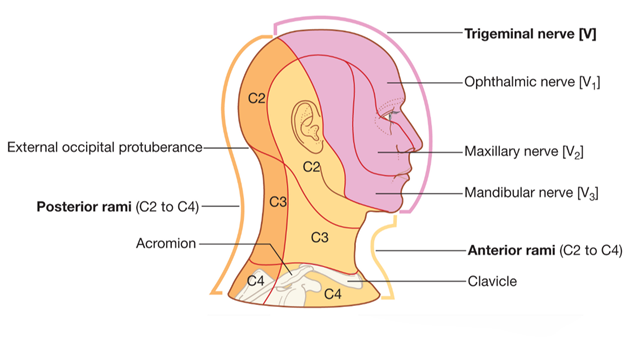Trigeminal Neuralgia Treatment
Trigeminal is 5th cranial nerve. It supplies face unilaterally through three divisions; ophthalmic, maxillary & mandibular. It never crosses the midline. Trigeminal Neuralgia is the classic neuropathic pain syndrome.
Clinical features:
It is a severe, almost exclusively unilateral, neuropathic pain located within the distribution of a trigeminal nerve, i.e. the eyes, lips, nose, scalp, forehead, and jaw. It manifests as paroxysmal high-intensity stabbing pain lasting seconds. Each attack may be followed by a refractory period, a period of relief that lasts seconds, minutes, or even hours.

To describe the pain sensation, patients may describe a trigger area on the face, so sensitive that touching or even air currents can trigger an episode of pain. It affects lifestyle as it can be triggered by common activities in a patient’s daily life, such as eating, talking, shaving and toothbrushing. Pain attacks typically worsen in frequency or severity over time. A great deal of patients develop the pain in one branch, then over the years, the pain will travel through the other nerve branches.
The diagnosis of trigeminal neuralgia is made from clinical history. No medical testing is available to confirm the diagnosis; however response to carbamazepine is considered as diagnostic by some.
Treatment Options
Medical management:
This aimed at providing rapid & sustainable pain relief with the least amount of side effects. Antiepileptic drug Carbamazepine is the drug of choice. If it is not tolerated, other medications used like baclofen, gabapentin, oxcarbazepine, pregabalin, clonazepam. Etc. Many people find relief with medication.
Intervention:
Interventions are considered for those who failed medical treatment or unable to tolerate side effects.
Radiofrequency trigeminal (retrogasserian) rhizotomy is used to treat intractable trigeminal neuralgia. It may selectively destroy the unmyelinated or poorly myelinated nociceprtive nerve fibers & spares the myelinated fibers that serve touch, proprioception and motor function.
Baloon decompression, percutaneous glycerol rhizotomy or surgical options named microvascular decompression (MVD) can be done.



